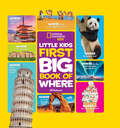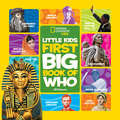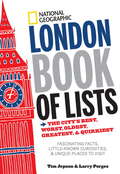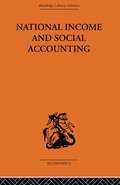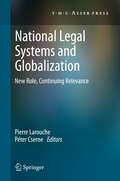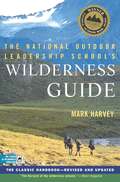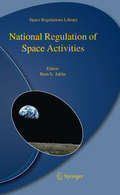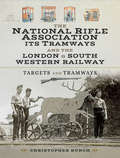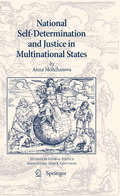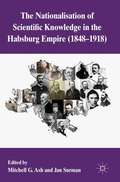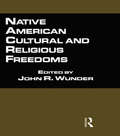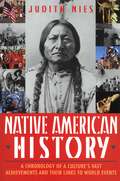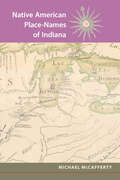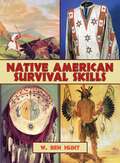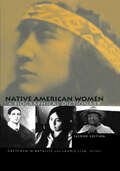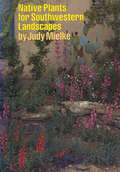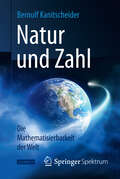- Table View
- List View
National Geographic Little Kids First Big Book of Where (National Geographic Little Kids First Big Books)
by Jill EsbaumPreschoolers are full of "Where?" questions, and this next book in the best-selling Little Kids First Big Book series is full of fascinating and often surprising answers for them.This charming reference book zeroes in on location, location, location. More than 200 colorful photos are paired with age-appropriate text featuring answers to questions like, "Where does the sky end?" "Where is the highest mountain?" and, "Where was ice cream invented?" Containing several kid-friendly maps designed to expand the learning experience, this book inspires kids to be curious, ask questions, and explore the world around them.
National Geographic Little Kids First Big Book of Who (National Geographic Little Kids First Big Books)
by Jill EsbaumIntroduce young readers to some of the world's most interesting and important people in this bold and lively first biography book. More than 100 colorful photos are paired with age-appropriate text featuring profiles of each person, along with fascinating facts about about their accomplishments and contributions. This book inspires kids about a world of possibilities and taps into their natural curiosity about fascinating role models from education advocate Malala Yousafzai to astronaut Neil Armstrong.
National Geographic Little Kids First Big Book of Why 2 (National Geographic Little Kids First Big Books)
by Jill EsbaumFollowing up on the best-selling Little Kids First Big Book of Why, the next book in the hit Little Kids First Big Book series features even more of the endless "Why?" questions preschoolers love to ask!This charming reference book answers some of kids' most burning "Why?" questions. More than 200 colorful photos are paired with age-appropriate text featuring answers to questions like "Why do dogs sniff everything?" "Why do I burp?" and "Why is ocean water salty?" This book inspires kids to be curious, ask questions, and explore the world around them.
National Geographic London Book of Lists: The City's Best, Worst, Oldest, Greatest, and Quirkiest
by Tim JepsonOrganized with a minimum of organization, the 140 lists in this eclectic and hugely entertaining illustrated compendium cover the city's best, worst, highest, smallest, first, last, and everything in-between. Among the many intriguing facts, stats, and snippets, you'll discover: Where you can find six old windmills within the confines of metropolitan London; Why the women's restroom at an East End pub is especially popular with avant-garde artists; When a tornado razed nearly 600 houses and destroyed London Bridge; The address of the only London flat where the four members of the Beatles lived together; Why local children beat the stone boundaries outside the Tower of London with willow branches every three years; Where you can find London's eight best waterfront pubs, seven greatest Victorian gin palaces, and ten most historic pubs; Which two famous London museums still show World War II bomb damage on their outer walls Royal palaces. Street markets. Stellar views. Cockney slang. Favorite meals of kings. Roman ruins. Secrets lost to time. With surprises on every page, National Geographic London Book of Lists takes you deep inside the city that never fails to fascinate.
National Geographic London Book of Lists
by Larry Porges Tim JepsonFor London lovers of all stripes, National Geographic London Book of Lists chronicles this ever-changing city from its ancient Roman origins to the present day. Organized with a minimum of organization, the 140 lists in this eclectic and hugely entertaining illustrated compendium cover the city's best, worst, highest, smallest, first, last, and everything in-between. Among the many intriguing facts, stats, and snippets, you'll discover: · Where you can find six old windmills within the confines of metropolitan London · Why the women's restroom at an East End pub is especially popular with avant-garde artists · When a tornado razed nearly 600 houses and destroyed London Bridge · The address of the only London flat where the four members of the Beatles lived together · Why local children beat the stone boundaries outside the Tower of London with willow branches every three years · Where you can find London's eight best waterfront pubs, seven greatest Victorian gin palaces, and ten most historic pubs · Which two famous London museums still show World War II bomb damage on their outer walls Royal palaces. Street markets. Stellar views. Cockney slang. Favorite meals of kings. Roman ruins. Secrets lost to time. With surprises on every page, National Geographic London Book of Lists takes you deep inside the city that never fails to fascinate. From the Hardcover edition.
National Geographic Tales of the Weird: Unbelievable True Stories
by David BraunWhen a farmer in Spain captured a two-headed snake in 2002, scientists wanted to study it. When National Geographic Daily News published a story about the discovery, people wanted to read all about it. More than a million people clicked on the site and kept coming back for more unbelievably true stories. An Internet sensation was born.
National Geographic Tales of the Weird
by David BraunWhen a farmer in Spain captured a two-headed snake in 2002, scientists wanted to study it. When National Geographic Daily News published a story about the discovery, people wanted to read all about it. More than a million people clicked on the site and kept coming back for more unbelievably true stories. An Internet sensation was born.Since then, more than 100 million individuals have clicked on stories put together by David Braun and his crack team of editors for National Geographic Daily News. And readers cannot get enough information about the often weird, sometimes miraculous things being discovered by scientists every day--incredible flying sharks, the strange sex lives of ducks, mind-controlling fungus that turns ants into zombies, and the darkest planet in the universe. This reader features the most wildly popular, incredibly weird, and totally true stories from National Geographic's Daily News site presented in a compact, fact-filled reader. It will be a must-have for fans of Braun's website and for fans of "fun fact" books like the Uncle Johns Bathroom Reader series. The millions of fans who follow David Braun's National Geographic Daily News will be thrilled with this incredible reader filled with their favorites from the website. The most popular ones are all here presented in a lively, engaging format that is entertaining for the mind and easy on the wallet.
National Income and Social Accounting (Routledge Library Editions)
by Ronald Cooper Profesor Harold Edey Harold C. Edey Professor Sir Peacock Alan T. Peacock'A very useful introduction to the techniques of social accounting' Bankers' Magazine.'Remarkable feat of compression and expositionit will surely remain for a long time the best summary of macro-accounting techniques' Accounting Research. This volume covers developments both in the scope and content of official economic statistics of national income and expenditure and in their use for short-term and long-term economic planning.
National Legal Systems and Globalization
by Pierre Larouche Péter CserneThis book presents the results of research project financed by the Hague Institute for the Internationalization of Law (HiiL) and carried out at the Tilburg Law and Economics Center (TILEC) of Tilburg University. The project team shows that globalization, instead of threatening national legal systems, put them in a new role and gives them continuing relevance. First of all, once one takes a more functional view of the law, based on law and economics and comparative law literature, harmonization or unification of national legal systems is no longer a foregone conclusion. Secondly, fundamental constitutional principles continue to bear in the era of multi-level and transnational governance: they become governance principles, divorced from specific institutional settings. Finally, looking beyond regulatory competition and comparative law, legal emulation provides a rich and fruitful model to explain the interplay between legal systems. This book explores these three themes, both at a theoretical level and in the light of specific examples.
The National Outdoor Leadership School's Wilderness Guide: The Classic Handbook, Revised and Updated
by Mark HarveyThe classic backpacker’s handbook—revised and updated—providing expert guidelines for anyone who loves the outdoors.The Wilderness Guide brings the savvy of the world's most famous and respected outdoor organization to everyone—from the sixteen million backpacking Americans to the more than 265 million people, tenderfeet and trail-hardened hikers, who visit our national parks annually. It covers: -Selecting equipment—including discussions of the advantages and disadvantages of products such as the internal frame pack, lighter-weight boots, and freestanding tents -The latest “leave no trace” camping techniques -Traveling safely and sensibly—including vital information on maps, compasses, and tips on crossing difficult terrain -Backcountry cooking, with tips on building fires and tricks for making gourmet meals -Search-and-rescue techniques, including how to organize a self-sufficient search group and when to call in professional rescue teams Illustrated throughout with instructional drawings and photos and featuring lists of equipment, the Wilderness Guide is a must-have for anyone planning to explore the great outdoors.
National Regulation of Space Activities
by Ram S. JakhuThis book comprehensively addresses all aspects of national space laws and regulations governing the conduct of space activities in fifteen space-faring nations. This is the first book of its kind that contains a compilation of materials written from a neutral and objective perspective by the world's leading space law experts selectively drawn from the fifteen countries whose laws and regulations are covered by the book. In order to provide the reader with a full understanding and appreciation of the various relevant national laws and regulations that govern space activities, this book explores the policies and rationales underlying the law, constitutional basis for the adoption of national space laws, some facts about national space activities in the respective countries, and as well, discusses the relevant principles and rules of international space law in order to bring to light the international context of the national laws described. Since the U.S. presently has the most developed and extensive regime of national space laws and regulations, six chapters of this book are devoted to a thorough examination of those laws and regulations. The unique feature of this compilation is that, apart from the description of applicable national laws and regulations on space activities that it provides, it also sets out the various procedures to be followed particularly by domestic and foreign private entities in order to achieve compliance with the numerous and varied national legal requirements concerning space activities. This work will be a valuable resource not only to students, researchers and academics in the fields of space law and regulation, but also to space industry executives, specialist lawyers, foreign ministries as well as international organizations, such as the United Nations.
The National Rifle Association Its Tramways and the London & South Western Railway: Targets and Tramways
by Christopher BunchThis unique reference work chronicles the interconnected histories of Britain&’s NRA and the British Railways Companies. The National Rifle Association of the United Kingdom was founded in the mid-nineteenth century and was granted a Royal Charter of Incorporation by Queen Victoria in 1890. Created for the encouragement of the Volunteer Rifle Corps and the promotion of rifle shooting throughout Great Britain, its popularity soon influenced the development of railway expansion. The London and South Western Railway Company even built unique tramways to connect the NRA&’s camps and ranges. This book sheds light on the fascinating relationship between the NRA and the British Railways Companies. Beginning in the 1860s, the NRA held annual marksmanship competition at Wimbledon Common, a site chosen for its accessibility from across the existing railway network. The NRA later established its new home at Bisley Camp in Surrey, some 35 miles outside London. The L&SWR built a spur from Brookwood Station and offered a discount on return fair to uniformed volunteers.
National Self-Determination and Justice in Multinational States
by Anna MoltchanovaSubstate nationalism, especially in the past fifteen years, has noticeably affected the political and territorial stability of many countries, both democratic and democratizing. Norms exist to limit the behavior of collective agents in relation to individuals; the set of universally accepted human rights provides a basic framework. There is a lacuna in international law, however, in the regulation of the behavior of groups toward other groups, with the exception of relations among states. The book offers a normative approach to moderate minority nationalism that treats minorities and majorities in multinational states justly and argues for the differentiation of group rights based on how group agents are constituted. It argues that group agency requires a shared set of beliefs concerning membership and the social ontology it offers ensures that group rights can be aligned with individual rights. It formulates a set of principles that, if adopted, would aid conflict resolution in multinational states. The book pays special attention to national self-determination in transitional societies. The book is intended for everyone in political philosophy and political science interested in global justice and international law and legal practitioners interested in normative issues and group rights
The Nationalization of Scientific Knowledge in the Habsburg Empire, 1848–1918
by Mitchell G. Ash Jan SurmanThis volume challenges the widespread belief that scientific knowledge as such is international. Employing case studies from Austria, Poland, the Czech lands, and Hungary, the authors show how scientists in the late Habsburg Monarchy simultaneously nationalized and internationalized their knowledge.
Native American Cultural and Religious Freedoms (Native Americans And The Law Ser. #Vol. 5)
by John R. WunderFirst Published in 2000. Routledge is an imprint of Taylor & Francis, an informa company.
Native American History: A Chronology of a Culture's Vast Achievements and Their Links to World Events
by Judith NiesA NEW PERSPECTIVE ON NATIVE AMERICAN HISTORY:A CHRONOLOGICAL ACCOUNT OF ITS PLACE ON THE WORLD STAGE.Native American History is a breakthrough reference guide, the first book of its kind to recognize and explore the rich, unfolding experiences of the indigenous American peoples as they evolved against a global backdrop. This fascinating historical narrative, presented in an illuminating and thought-provoking time-line format, sheds light on such events as:* The construction of pyramids--not only on the banks of the Nile but also on the banks of the Mississippi * The development of agriculture in both Mesopotamia and Mexico* The European discovery of a continent already inhabited by some 50 million people * The Native American influence on the ideas of the European Renaissance* The unacknowledged advancements in science and medicine created by the civilizations of the new world* Western Expansion and its impact on Native American land and traditions* The key contributions Native Americans brought to the Allied victory of World War II And much more!This invaluable history takes an important first step toward a true understanding of the depth, breadth, and scope of a long-neglected aspect of our heritage.From the Trade Paperback edition.
Native American Place Names of Indiana
by Michael McCaffertyA linguistic history of Native American place-names in Indiana In tracing the roots of Indiana place names, Michael McCafferty focuses on those created and used by local Native Americans. Drawing from exciting new sources that include three Illinois dictionaries from the eighteenth century, the author documents the language used to describe landmarks essential to fur traders in Les Pays d’en Haut and settlers of the Old Northwest territory. Impeccably researched, this study details who created each name, as well as when, where, how and why they were used. The result is a detailed linguistic history of lakes, streams, cities, counties, and other Indiana names. Each entry includes native language forms, translations, and pronunciation guides, offering fresh historical insight into the state of Indiana.
Native American Survival Skills: How To Make Primitive Tools And Crafts From Natural Materials
by W. Ben HuntW. Ben Hunt, whose Sioux name was Tasunka Witko, traveled throughout the Midwest, living with several Native American tribes, finally settling near the site of the last Sioux uprising. Here he provides step-by-step instructions and exact dimensions to make Sioux ghost shirts, Plains Indian shields, box traps, Iniut snowshoes, and more. From making rawhide to putting the finishing touches on a pair of moccasins, beginners and seasoned woodsmen alike will enjoy making the tools and camp equipment that were used for centuries. Native American Survival Skills is a remarkable source of information about the Americans who first pioneered self-sufficient living. In it, there are lessons for all of us today.
Native American Women: A Biographical Dictionary (Biographical Dictionaries of Minority Women)
by Gretchen M. Bataille Laurie LisaThis A-Z reference contains 275 biographical entries on Native American women, past and present, from many different walks of life. Written by more than 70 contributors, most of whom are leading American Indian historians, the entries examine the complex and diverse roles of Native American women in contemporary and traditional cultures. This new edition contains 32 new entries and updated end-of-article bibliographies. Appendices list entries by area of woman's specialization, state of birth, and tribe; also includes photos and a comprehensive index.
Native Plants for Southwestern Landscapes
by Judy MielkeA guide to xeriscaping for eco-conscious gardeners living in desert climates. For gardeners who want to conserve water, the color, fragrance, shade, and lush vegetation of a traditional garden may seem like a mirage in the desert. But such gardens can flourish when native plants grow in them. In this book, Judy Mielke, an expert on Southwestern gardening, offers the most comprehensive guide available to landscaping with native plants. Writing simply enough for beginning gardeners, while also providing ample information for landscape professionals, she presents over three hundred trees, shrubs, vines, grasses, groundcovers, wildflowers, cacti, and other native plants suited to arid landscapes. The heart of the book lies in the complete descriptions and beautiful color photographs of plants native to the Mojave, Sonoran, and Chihuahuan desert regions of the Southwestern United States and northern Mexico. Mielke characterizes each plant and gives detailed information on its natural habitat, its water, soil, light, temperature, and pruning requirements, and its possible uses in landscape design. In addition, Mielke includes informative discussions of desert ecology, growing instructions for native plants and wildflowers, and &“how-to&” ideas for revegetation of disturbed desert areas using native plants. She concludes the book with an extensive list of plants by type, including those that have specific features such as shade or fragrance. She also supplies a list of public gardens that showcase native plants.
Natur und Zahl: Die Mathematisierbarkeit der Welt
by Bernulf KanitscheiderDie Mathematik hat sich seit dem Entstehen der modernen Naturwissenschaft im 16. Jh. als das entscheidende Erkenntnisinstrument erwiesen, so dass die Mathematisierung der Theorien eines Faches als Kriterium seiner Reife betrachtet wurde. Dennoch ist der Grund für diesen unerwarteten Anwendungserfolg immer dunkel geblieben. Warum lässt sich die materielle Natur mit dem geistigen Werkzeug der Zahlen und geometrischen Formen so perfekt erfassen? Diese Frage ist eng verknüpft mit dem ontologischen Status abstrakter Objekte: Wo sind sie beheimatet, in den Dingen als Strukturen, im Hintergrund als Ideen, oder sind sie nur Fiktionen? Die Hypothese dieses Buches folgt einer Idee von P.A.M. Dirac, der vermutete, dass die Natur eine innere mathematische Qualität besitzt.
Natural Categories and Human Kinds
by Muhammad Ali KhalidiThe notion of 'natural kinds' has been central to contemporary discussions of metaphysics and philosophy of science. Although explicitly articulated by nineteenth-century philosophers like Mill, Whewell and Venn, it has a much older history dating back to Plato and Aristotle. In recent years, essentialism has been the dominant account of natural kinds among philosophers, but the essentialist view has encountered resistance, especially among naturalist metaphysicians and philosophers of science. Informed by detailed examination of classification in the natural and social sciences, this book argues against essentialism and for a naturalist account of natural kinds. By looking at case studies drawn from diverse scientific disciplines, from fluid mechanics to virology and polymer science to psychiatry, the author argues that natural kinds are nodes in causal networks. On the basis of this account, he maintains that there can be natural kinds in the social sciences as well as the natural sciences.
Natural Cleaning Secrets
by Reader'S DigestSave time and money with natural cleaning hacks for a healthier, greener household by using items you already have at home such as vinegar, baking soda and lemon juice.Discover the natural way to keep your home clean for less time and money. Natural Cleaning Solutions features: Natural cleaning solutions that are effective and affordable. Sound advice that truly works and is so simple that you will see how easily you can make the change in your everyday life. Homemade recipes to get you started making your own natural dishwashing liquid, laundry detergent, facial cleansers, and much more—using items you probably already have at home, such as baking soda, salt, vinegar, and lemon. When you follow the tips in Natural Cleaning Solutions, you&’ll not only enjoy a gleaming and freshly scented home free from toxic chemicals, you&’ll spend less time and money at the store and you&’ll create less waste. So you can feel good about doing your bit to help the environment. And the best part is everything here is natural!
Natural Compounds: Cycloartane Triterpenoids and Glycosides
by Shakhnoza S. Azimova'Natural Compounds: Plant Sources, Structure and Properties' details the properties of over 7,500 chemical compounds of pharmacological interest found in plants. Each volume systematically covers occurrence of the compounds in plants, illustrations of chemical structures plus physical-chemical, spectral, and pharmacological data. Entries are indexed by plant name, subject, and pharmacological property. This provides unique coverage of information on compounds isolated from some 3,000 plants, including many from central Asia and Russia, that are not well known elsewhere. The entries for each compound share a similar format. The entries are preceded by tabulated information on the occurrence of the compounds in plants etc. The highly experienced team of compilers from the renowned Institute of the Chemistry of Plant Substances in Tashkent have expertly assessed the international literature and include data only when confident of its validity, e.g. excluding data where measurement processes cause degradation of the original compound.
Natural Compounds: Triterpene Glycosides. Part 1 and Part 2
by Shakhnoza S. Azimova'Natural Compounds: Plant Sources, Structure and Properties' details the properties of over 7,500 chemical compounds of pharmacological interest found in plants. Each volume systematically covers occurrence of the compounds in plants, illustrations of chemical structures plus physical-chemical, spectral, and pharmacological data. Entries are indexed by plant name, subject, and pharmacological property. This provides unique coverage of information on compounds isolated from some 3,000 plants, including many from central Asia and Russia, that are not well known elsewhere. The entries for each compound share a similar format. The entries are preceded by tabulated information on the occurrence of the compounds in plants etc. The highly experienced team of compilers from the renowned Institute of the Chemistry of Plant Substances in Tashkent have expertly assessed the international literature and include data only when confident of its validity, e.g. excluding data where measurement processes cause degradation of the original compound.
